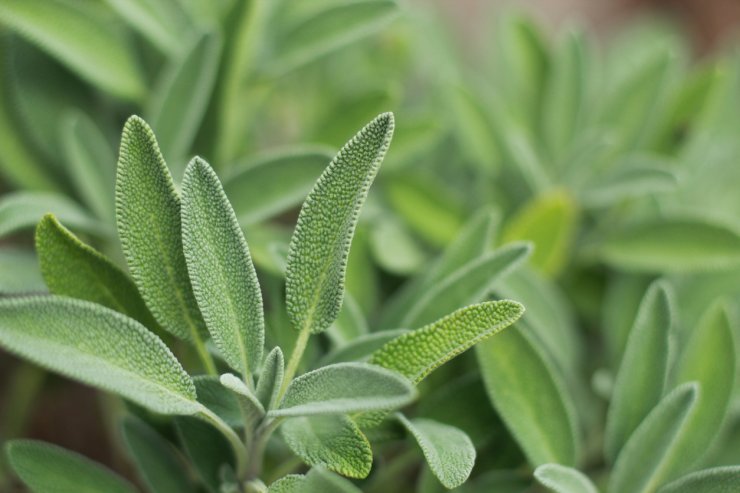
Sage plant
You know the refrain “Parsley, sage, rosemary, and thyme?” Well, those four herbs have more in common than just Scarborough Fair. They’re four of the most popular, easy-to-grow culinary plants. However, sage stands out, because it not only enhances other flavors in cooking, but also has proven healing properties for your physical and mental well-being. That’s why it’s wise to grow your own sage—it’s economical and time-saving as a little goes a long way.
You’ll recognize common garden sage from its color—that silvery gray green with a whitish underside. But many cultivars of this plant have a purple tinge to their leaves, and some are variegated with cream or yellow. The flowers range from purple to blue to bright red.
Sage is a woody-stemmed perennial in USDA Plant Hardiness Zones 5 to 8, and in milder climates you can harvest it year-round. This shrubby plant spreads over the years, so, if well-tended, one plant will provide bountiful leaves for four to five years. Even if you don’t plan to harvest your sage, including it in your garden will benefit surrounding plants, as sage attracts beneficial insects and its scent wards off many pests, including deer.
Botanically speaking, sage (salvia officinalis) is a member of the mint family. That’s why sage has both a savory and sometimes a slightly sweet flavor. Some sage types offer a lightly lemony taste. Brush your fingers along the leaves and the distinctive pleasant aroma will waft up into the air, a clarifying scent that cleans the air and sharpens the mind.
The flavor of sage leaves also varies depending on the age and size of the leaf: the larger the leaf, the more intense the flavor. Therefore, it’s important to know when to harvest the leaves, depending on how you are going to use them. And, sage is used in a wide variety of ways, from a food flavoring to medicinal teas to rodent repellent!
While there are literally, hundreds of varieties of sage, this collection features six popular varieties that will give you some diversity in your harvest to help feed your kitchen and fill your medicine cabinet with different sages for different purposes. All sage falls into these scientific hierarchy classifications:
- Kingdom: Plantae (plants)
- Order: Lamiales (flowering plants)
- Family: Lamiaceae (mint family)
- Genus: Salvia L. (sage)
- Species: Salvia officinalis (kitchen sage)
A Brief History of Sage
Sage, also referred to as salvia, originated in the hot, dry Mediterranean region. The name comes from the Latin salvere—to be saved, or healed—which makes sense as sage has been used for medicinal purposes for centuries. In fact, in 812 A.D., Charlemagne himself deemed the herb so important he ordered it planted on German Imperial farms, recognizing its benefit for both medicine and trade.
The Egyptians associated sage with fertility and the French used it to make tea. In the Middle Ages, monks included sage among 16 herbs they grew for healing, and used it as a pharmaceutical. The Chinese also appreciated sage’s medicinal attributes, using it for everything from colds and joint pain to typhoid fever. Sage tea has long been used to alleviate a range of ailments.
Perhaps sage’s savory uses evolved from the Romans’ use of the herb to aid digestion, pairing sage with the fatty meats eaten at that time. Or, when they and the ancient Greeks discovered its usefulness as a meat preservative. No wonder today we most often associate culinary sage with our Thanksgiving turkey!
The ancients also used sage in mystical ways. The Romans incorporated the “holy herb” in religious rituals. Native Americans and other indigenous peoples have burned sage in spiritual rituals—known as smudging—to clear away negative energy and refresh a space, or a person, and promote healing and wisdom.
Today, people still use sage for medicinal, culinary, and spiritual purposes. Although most know sage from its star turn at Thanksgiving, you’ll soon see that sage can be one of the highlights of your garden.
Culinary sage can be used as a flavoring or a garnish. You can combine chopped leaves with butter to make sage butter—delicious on corn, bread, or with pasta. Sage complements poultry perfectly, and vegetarians and vegans will love how it adds heartiness to roasted vegetables and fall favorites such as pumpkin and butternut squash. Check out our Recipes, and you’ll realize the endless possibilities when you cook with sage!
Did you know this history and background of sage? Were you aware of sage’s ancient relevance? Do you enjoy sage all year long—or just at Thanksgiving? Please tell us what you think about sage.


 Previous
Previous


Is hummingbird sage edible? More details please?
a sage leaf can numb the gums after a root cannel or toothache, sooths the pain.